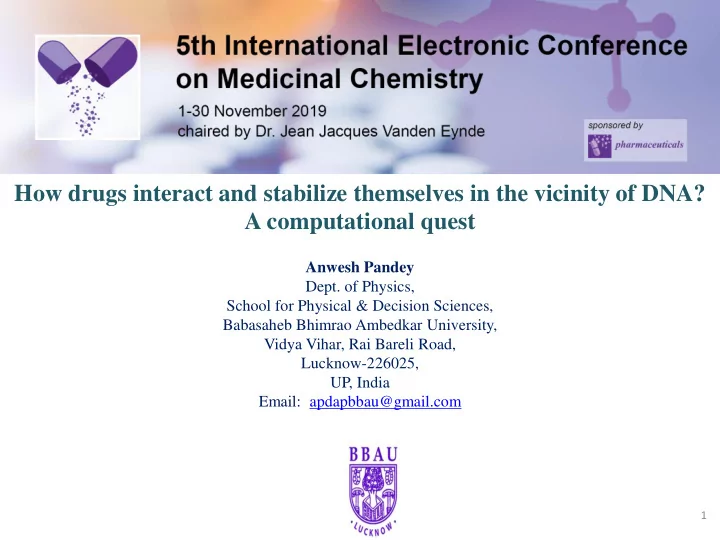

How drugs interact and stabilize themselves in the vicinity of DNA? A computational quest Anwesh Pandey Dept. of Physics, School for Physical & Decision Sciences, Babasaheb Bhimrao Ambedkar University, Vidya Vihar, Rai Bareli Road, Lucknow-226025, UP, India Email: apdapbbau@gmail.com 1
How drugs interact and stabilize themselves in the vicinity of DNA? A computational quest 2
ABSTRACT Deoxyribonucleic acid has been known cellular target for many anticancer agents from several decades. The interaction of drugs with nucleic acid is one of the important features in pharmacology and plays significant role to understand the mechanism of drug action and in designing of more efficient drugs with lesser side effects. In the current research work, diarylfurans which were claimed to possess antimicrobial tendencies were studied for their relative binding strengths and stable complex formation tendencies with DNA (PDB Id: 195D). Molecular docking calculations were performed to predict binding pocket of the drug in the vicinity of DNA and molecular dynamics (MD) were performed to study the interaction dynamics in support of predicted binding mode. Docking revealed that the binding site was AT-rich region, as preferred by minor groove binders. RMSD and RMSF analysis were done from the obtained from MD studies; the former study revealed that ligands remain bound to the preferred binding positions of the DNA without any considerable deviations in its minor groove; however the later revealed the topological structure of DNA remaining intact during the entire course of the simulation, inferring the stability of drug-DNA complexes. ADMET prediction studies were done in order to get an insight to the chemical perspectives of the drugs and their possible human bioassays. This study describes the properties and dynamics of DNA on the interaction with minor groove binders, taking the account of deformation upon binding which can play significant role in the discovery of new minor groove binder as a regulator of gene expression. Keywords: Diarylfurans, Docking, Molecular Dynamics, Stability, RMSD, RMSF. 3
Introduction DNA minor groove is the target for many anticancer and antitumor drugs. The forces that involves in DNA- minor groove bindings are electrostatic, van der Waals, hydrophobic, and hydrogen bonding. Sequence specificity is important key tool for the drug-DNA interaction and another important factor for the interaction is that the small molecule has a crescent shape which is complementary to the minor groove of DNA. Frequently, minor groove shows selectivity towards AT region, several factors are responsible for this first is the electrostatic potential of AT-rich region is higher than that of GC-filled ones and another one is that the AT-rich grooves are narrower and deeper than GC ones. DNA minor groove with alternating A and T, allows favorable van der Waals contacts between the drug and DNA instead of GC-rich region where the geometry of groove is altered by bulky amino groups of guanine bases. In the current study, some different class of minor groove binder's (diarylfurans) labeled as mol-1, mol-2 & mol-3 are undertaken, followed by DNA sequence (PDB Id: 195D). Molecular modeling techniques such as molecular docking & molecular dynamics simulation were used for the current research. ADMET studies were also performed for better understanding of the chemical properties of selected drugs. Molecular Docking is simplest computational representation of DNA-ligand interaction and usually not able to predict the correct binding affinity using AUTODOCK. There are many studies for the comparison of force fields for the nucleic acids but AMBER force fields seems to be good for nucleic acid simulation due to the presence of specific topologies for the terminal nucleotides. The ADMET (absorption, dissolution, metabolism, excretion and toxicity) predictions viz., classification values and regression values, of all the selected ligands was also performed to improve their drug like properties and characteristics. This study reveals that the selected compounds can be substituted only by their derivatives to improve their drug like properties.
Results And Discussion A. Optimized Ligands: B. Docked Ligands: 5
C. MD Results: 6
Conclusions: The computational studies that were performed here were done in order to evaluate and analyze the binding energies of selected DNA minor groove binders. The main aim of this study was to provide a detailed perspective on drug-DNA interactions at the atomistic levels. Thus, our study attempts to give detailed insight on the complexity in binding modes of small molecules to DNA including the stability and varies interactions occurring. Theses analysis will be helpful for the improvement of existing minor groove binders as anticancer agents and would also prove fruitful in designing novel chemical entities which can act as good cancer inhibitors. This study will also provide a theoretical/computational protocol for complementing various existing experimental techniques and generation of a theoretical database for structure-energy relationship in drug-DNA complexes. 7
Acknowledgments: Anwesh Pandey would like to acknowledge University Grants Commission, Govt. of India, New Delhi for the financial assistance during the course of this research work. Questions and Answers section including Discussions Panel of Research Gate website is also duly acknowledged. 8
Recommend
More recommend